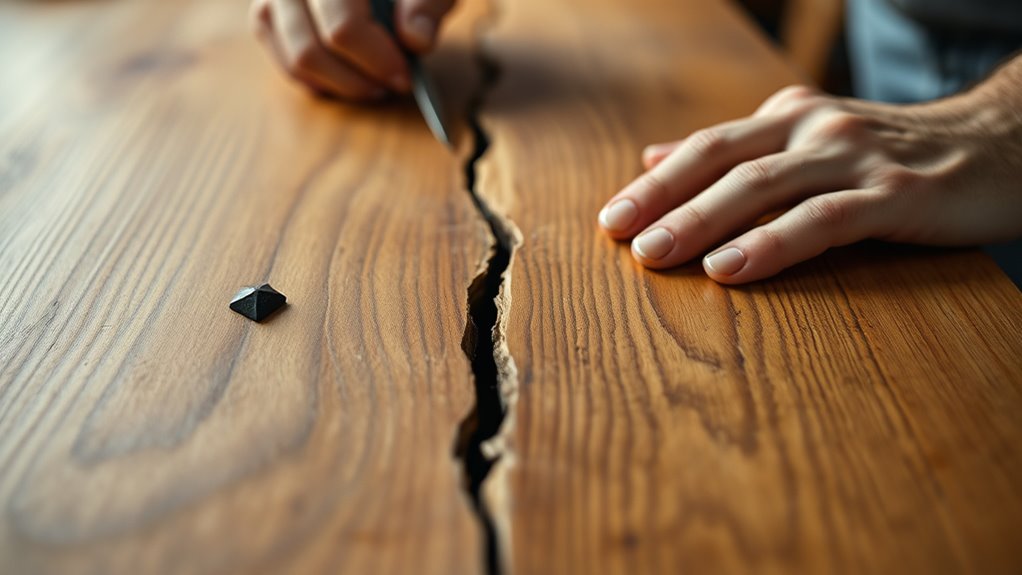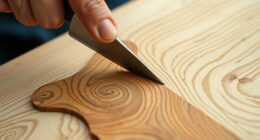When fixing a split tabletop, decide between butterfly keys and glue-only repairs based on the crack’s size and your desired look. Butterfly keys are more decorative, adding strength and visual appeal, especially for larger or high-stress cracks. Glue-only fixes are simpler, quicker, and work well for minor splits. To guarantee a successful repair, proper preparation and technique matter. Keep exploring to discover detailed tips that will help you achieve the best results.
Key Takeaways
- Butterfly keys provide a durable, decorative fix suitable for large or high-stress splits, while glue-only repairs are quicker for minor cracks.
- Glue-only repairs are simpler, less visible, and cost-effective but may require reapplication over time.
- Butterfly keys reinforce the joint and add character, making them ideal for aesthetic and structural restoration.
- Proper cleaning, precise fitting, and clamping are essential for both methods to ensure a strong, lasting repair.
- Choice depends on split size, location, desired appearance, and skill level; larger splits benefit from butterfly keys.

A split tabletop can be frustrating, but fixing it is often straightforward if you know the right steps. When your table begins to crack or split, you have a couple of options for repair: using butterfly keys or opting for glue-only repairs. Both methods can restore stability, but each has its advantages and considerations.
Butterfly keys are a traditional and visually appealing solution. They involve cutting a small, decorative insert into the underside of the split, then gluing and securing it in place. The key’s shape resembles a butterfly, which is how it gets its name. This method not only reinforces the joint but also adds a bit of character to your table. You’ll need to carefully measure and cut the butterfly key to fit snugly into the slot, then glue it in with a strong wood adhesive. Once dried, the butterfly key provides a sturdy, long-lasting fix that can prevent future splits, especially in high-stress areas. This approach is particularly effective if you want a repair that blends seamlessly with the wood’s natural aesthetic or if the split is near an edge where a decorative touch is desirable.
Butterfly keys reinforce joints with decorative, durable inserts that blend seamlessly into your table’s design.
On the other hand, glue-only repairs are simpler and faster. They involve applying a high-quality wood glue directly into the split, pressing the two sides together firmly, and clamping until the adhesive cures. This method works well for minor splits or cracks that don’t compromise the table’s structural integrity too much. It’s a cost-effective solution that requires minimal tools and effort. However, glue-only repairs may not be as durable as those reinforced with butterfly keys, especially if the split is in a high-stress area or if the wood is prone to movement. To ensure success, you should thoroughly clean the split area, remove any debris or old finish, and apply the glue evenly to prevent gaps. Clamping tightly during curing ensures the adhesive bonds properly and the joint remains strong.
Choosing between butterfly keys and glue-only repairs depends on the size and location of the split, your skill level, and how visible you want the repair to be. Butterfly keys offer a more permanent and decorative fix, ideal for significant splits or when you want to preserve the table’s aesthetics. Glue-only repairs are quick, simple, and effective for minor cracks, but they might need to be redone over time if the split reopens. Additionally, understanding the wood grain and how it influences movement can help you make a better repair decision. Regardless of which method you choose, patience and proper preparation are key. Ensuring the wood is clean, the glue is applied correctly, and the components are clamped securely will give you the best chance at restoring your table to its former strength and appearance.
Frequently Asked Questions
Can Butterfly Keys Be Added After the Tabletop Is Finished?
Yes, you can add butterfly keys after finishing your tabletop. Using woodworking techniques, carefully cut the key slots into the surface, then insert the butterfly keys with appropriate repair materials like wood glue. This method helps reinforce the split and adds a decorative touch. Just make certain proper sanding and finishing afterward to blend the repair seamlessly with the existing surface, maintaining both strength and aesthetics.
Which Repair Method Is More Durable Long-Term?
You’ll find butterfly keys offer superior long-term durability because they mechanically lock the split together, preventing future separation. Imagine your tabletop enduring years of daily use without cracking or shifting—these repairs are built to last. While glue-only repairs might seem easier initially, they often lack the repair longevity needed for a sturdy, lasting fix. For a reliable, enduring solution, butterfly keys are the way to go.
Are There Aesthetic Differences Between Butterfly Keys and Glue-Only Repairs?
You’ll notice aesthetic differences between butterfly keys and glue-only repairs. Butterfly keys add a distinctive visual impact with their contrasting wood material, creating a decorative detail that highlights craftsmanship. In contrast, glue-only repairs tend to be less noticeable, blending seamlessly into the tabletop. If you want a repair that enhances the visual appeal, butterfly keys offer a striking material contrast, while glue-only repairs prioritize subtlety and a clean look.
How Much Time Does Each Repair Process Typically Take?
You’ll find that glue-only repairs typically take less time, often a few hours, since they’re less complex. Butterfly key repairs usually require more time, possibly a day or more, due to their higher complexity level and need for precise fitting and curing. If you’re aiming for a quicker fix, glue-only is faster, but if you want a stronger, more aesthetic repair, butterfly keys might be worth the extra time.
Is Special Woodworking Skill Required for Installing Butterfly Keys?
You don’t need extensive woodworking expertise to install butterfly keys, but you do require some skill and patience. Using precision tools helps guarantee accurate fitting and a clean finish. With proper guidance, basic woodworking knowledge can suffice. Focus on careful measurements and precise cuts, and you’ll successfully reinforce your tabletop. If you’re willing to learn and take your time, installing butterfly keys can be a manageable DIY project.
Conclusion
When repairing a split tabletop, think of it like mending a cracked windshield—you have options that range from delicate butterfly keys to seamless glue-only fixes. I once watched a craftsman use butterfly keys to restore a century-old table, and the result was like fitting puzzle pieces perfectly together, creating a sturdy, beautiful surface. Whether you choose keys or glue, your careful repair can transform a damaged piece into something stronger and more charming than before.









